Abstract
Through the establishment of a three-dimensional joint clearance model, the effects of joint clearances at different positions on shimmy stability are evaluated. In this paper, considering the radial, axial and coupling characteristics of joint clearance, the shimmy multibody dynamics (MBD) model is applied to different joints in the nose landing gear (NLG) transmission system. It is proposed to evaluate the influence of joint clearance on shimmy from two aspects of position factor and wear factor. The study found that different joint clearances have different effects on shimmy: the joint clearance between the NLG and fuselage has little influence on shimmy; the larger axial clearance of upper and lower torque link joint will cause the shimmy of the NLG, but the radial clearance has no effect on shimmy; while the joint clearance between turning sleeve and upper torque link, lower torque link and piston only works in the axial and radial coupling. The reasons for the different influence characteristics of each joint space are analyzed. Consequently, studying and summarizing the influence of different clearance on shimmy is of great significance for the design and maintenance of the NLG joints.
1. Introduction
Mechanical wear is a common and inevitable problem, and the general mechanical equipment parts are invalidated and scrapped due to wear. There are also wear phenomena in the joints of the aircraft NLG, such as the wear of washers, bushings and pins. Although the wear itself will not cause direct failure of the components, the joint clearance caused by wear will seriously affect the shimmy stability of the landing gear [1,2,3,4]. This will put forward higher requirements for the design of landing gear joints, such as the structural shape of joints, assembly dimensions and wear resistance of materials.
The wheel of the NLG may have a severe vibration that deviates from its central position, which is called shimmy [5]. The shimmy of the NLG will seriously affect the stability of the body and the ride comfort and aircraft operation, cause damage to the body and landing gear and endanger the safety of life and property. There are numerous factors affecting the shimmy of the NLG, including linear and nonlinear factors, which can be summarized into four parts: NLG structural characteristics [6,7,8,9,10], wheel characteristics [11,12,13], fuselage characteristics [14,15,16] and external conditions [17,18,19]. Among them, the structural clearance has strong nonlinearity and discontinuity, which makes the dynamic behavior of the system very complicated, and it also causes great difficulties to the vibration analysis of the landing gear system and the practical application of the analysis conclusions.
The existing literature on the influence of joint clearance on the shimmy of NLG is mostly a general parameter. As early as 1980, Grossman D.T [1] of the McDonnell-Douglas Company studied the influence of torsional clearance on the shimmy stability of the F-15 fighter, introduced the parameter of torsional clearance and constructed a mathematical model for shimmy analysis. In the early 21st century, Niranjan K. Sura [20] and B Sateesh [21] established a nonlinear shimmy dynamic model with torsional clearance. The results show that the torsional clearance reduces the stability of the NLG. Mohsen Rahmani [22] used the simscape multibody method to study the coupling characteristics of coulomb friction and clearance. None of the above can reflect the specific location of the joint clearance. In addition, the clearance model is a mathematical model, which cannot reflect the three-dimensional characteristics of the clearance model.
The general structural clearance includes product assembly clearance and wear clearance, and the value of each position clearance is different. Filipe Marques [23] proposed a new formula to simulate the spatial joints with radial and axial clearances; Yan et al. [24] considered the radial and axial clearances between the rotating shaft and the shaft sleeve, and based on the analysis of the geometric characteristics of the motion pair, 13 contact modes and their conditions were given. In addition, the influence characteristics of different joint clearances are different [25,26,27,28].
The NLG system contains multiple joints. Joint clearance wear occurs during the service of the NLG. The vibration and noise caused by joint clearance and its wear directly affect the stability and service life of the NLG. Especially after long-term work, the joint clearance increases with the deepening of wear, and these problems are more prominent [29,30]. The transmission characteristics of each joint of the NLG are different, and little is known about the influence of different joint clearance on shimmy. At present, there are no studies in the literature to distinguish and discuss it. Although many scholars have studied the shimmy suppression method of the NLG [31,32,33,34,35,36,37], it is impossible to establish the quantitative influence of joint clearance wear on NLG shimmy, which makes it difficult for the designer to analyze the reliability of the landing gear system, let alone accurately predict the joint life and monitor the motion state of the mechanism.
In this paper, taking a certain type of airliner as the research object, the shimmy MBD model with joint clearance at different positions is established based on LMS Virtual.Lab Motion. The clearance model is a three-dimensional space joint clearance model, considering the radial clearance, axial clearance and their coupling characteristics, which is more practical. The influence characteristics of different position clearance on shimmy are studied via the MBD model, and the critical clearance values of different joints are calculated quantitatively, which can easily determine the weak links that have a greater impact on the shimmy of NLG, so as to guide designers to improve the weak links in the aspects of joint design, material selection, manufacturing and so on. At the same time, it is also of great significance to provide a reference for the design and wear maintenance guidance of joint assembly dimension chain in different positions.
2. MBD Model of the NLG with Joint Clearance
2.1. Dynamic Equation of Multibody System
Taking the NLG of a certain airliner as the research object, the MBD model of NLG is constructed by using the dynamic simulation platform LMS Virtual.Lab Motion. The Cartesian coordinates of the rigid body center [x, y, z] are used to describe the translational degrees of freedom (DoF) of the rigid body in three directions, while the Euler quaternion [e0, e1, e2, e3] is used to describe the rotational DoF of the rigid body. Therefore, the generalized coordinates describing the DoF of a rigid body are , . In LMS Virtual.Lab Motion, Lagrangian undetermined multiplier method is applied to establish the dynamic equation of multibody system, which is suitable for efficient solution via the coefficient matrix method.
where is the Jacobian matrix of the constraint equation, M is the mass matrix, λ is the Lagrange multiplier, is the acceleration, is the system force, and γ is the second derivative term in the acceleration formula.
The constraint equation of the system, the Jacobian matrix of the constraint equation, the velocity equation, the acceleration equation and the Lagrange multiplier expression are given, respectively, by
2.2. Simplified Model of NLG
A simplified three-dimensional model including the outer cylinder of the strut, rotating sleeve, piston, wheel, upper and lower torque link, front brace tripod, front brace, lock brace and unlock actuator is constructed in LMS Virtual.Lab Motion, with removal of shimmy insignificant components. The relative motion of each part is realized by the motion pair, in which the motion relationship between the outer cylinder and the piston is a cylindrical pair, and the motion relationship between the upper lock brace and the unlock actuator is a fixed pair, and the rest is the rotating pair. The simplified model of the NLG established in this article is shown in Figure 1.
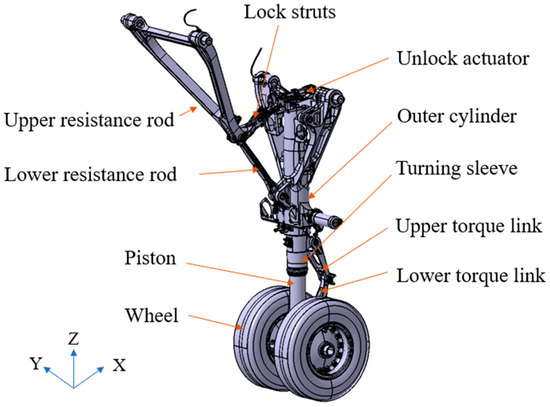
Figure 1.
Assembly model of the NLG.
2.3. Load Applied to NLG
Based on the above assembly model, the loads applied to the NLG system mainly include air spring force, oil damping force, structural limiting force, anti-shimmy damping torque and tire force, which are realized by different force elements in the LMS Virual.Lab virtual prototype platform, as detailed in Table 1. The calculation theory behind it is as follows.

Table 1.
Summary of load application.
2.3.1. Shock Absorber Load
Air spring force, oil damping force and structural limiting force play a role in the cushioning process of landing gear, absorbing the vertical kinetic energy of aircraft landing and taxiing through the gas–liquid high-speed collision and the energy dissipation effect of the damping hole. The data of the NLG shock absorber are shown in Table 2.

Table 2.
NLG shock absorber data.
The air spring force Fa, oil damping force Fd and structural limiting force F1 are specified as
where and d designate the stroke rate and damping coefficient, respectively. The maximum stroke of the shock absorber is 0.43 m. The oil damping coefficient d of the NLG shock absorber adopts piecewise linear function, as depicted in Figure 2. Due to the difference in damping hole diameters between positive stroke and reverse stroke, there is a great difference in the damping coefficient.
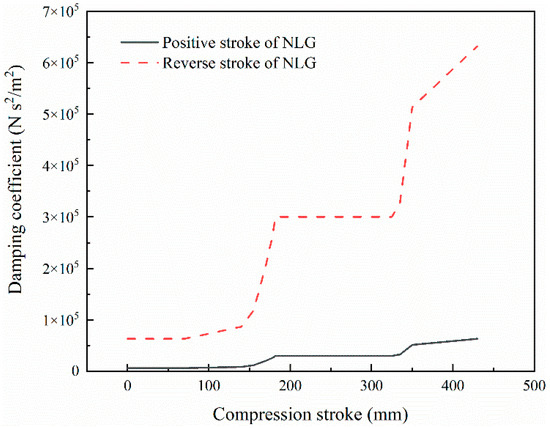
Figure 2.
Oil damping coefficient of positive and reverse stroke of the NLG shock absorber.
2.3.2. Shimmy Damper Load
The shimmy damper is designed between the turning sleeve and the piston, and there is a damping hole inside it. The hydraulic oil flows through the damping hole to produce an anti-shimmy damping torque rotating around the axis of the pillar, and the direction is opposite to the swing direction of the front wheel, thus dissipating the mechanical energy of the shimmy. The anti-shimmy damping torque is specified as
where Cd is the torsional damping of strut, and is the angular velocity of rotation.
2.3.3. Tire Load
The most widely used model of tire force is Smiley’s second-order tension string theory model [38]. In this paper, the NLG tire load adopts complex tire force elements in LMS Virtual.Lab Motion, which is based on tension string theory. The mechanical model of tire load is as follows:
where Ftire and Mtire are the force and moment acting on the tire on the ground, Kλ, Kφ, Cλ and Cφ are the lateral stiffness, torsional stiffness, lateral damping and torsional damping of the tire, respectively, y0 is the lateral offset of the tire touching the ground center, H is the vertical distance from the rotation axis to the wheel center, R is the rolling radius of the tire, α is the lateral rotation of the front wheel around the rotation axis, eeff is the equivalent stable distance, V is the taxiing speed of the aircraft, θs is the front wheel swing angle, HCA is the half length of the tire touching the ground, and LR is the tire relaxation length.
2.4. Establishment of Equivalent Model of Joint Clearance
The joint clearance of the NLG can be divided into radial clearance and axial clearance according to the azimuth. Because there is no module to establish the clearance model directly in LMS Virtual.Lab Motion, the equivalent models of radial clearance and axial clearance are established, respectively, through the existing modules, and the theory behind them is further introduced.
2.4.1. Equivalent Model of Radial Clearance
The joint radial clearance model is characterized by the sphere-to-extruded-surface contact model. The shaft is represented by several spheres with radius Ri, and the shaft hole is simulated by extrusion body with radius Rj. The equivalent model can capture the collision forces at different positions of the shaft. As described in Figure 3, the unilateral clearance value Rj-Ri is used to represent the radial clearance, which ranges from 0 to 1 mm in this paper.
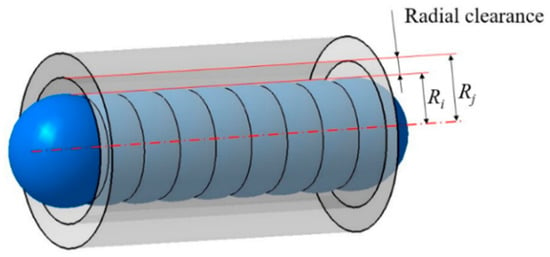
Figure 3.
Joint with radial clearance.
The normal contact force of the radial clearance model is composed of Hertz force, which is calculated automatically by LMS Virtual.Lab Motion, and the calculation formula refers to the study of Young, W. C. and Budynas R. G. [39]. Figure 4 presents the contact between two surfaces, and the specific formula is as follows:
where
where, at the point of contact, the minimum and maximum radius of curvature are R1 and for body 1, and R2 and for body 2, and δ is the penetration depth of collision, e is the coefficient of restitution, Vpen is the penetration velocity, Veps is the minimum penetration velocity, E1 is Young’s modulus body 1, E2 is Young’s modulus body 2, v1 is the Poisson’s ratio body 1, and v2 is the Poisson’s ratio body 2.
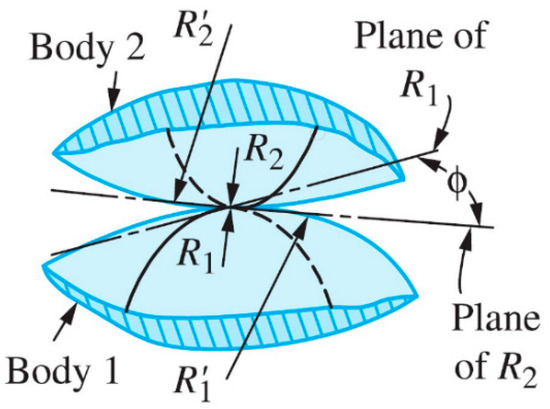
Figure 4.
Contact between two surfaces.
The tangential friction force is:
where μ is the sliding friction coefficient, and Fn is the normal force.
The joint connectors of the NLG are made of stainless steel (15-5PH) connecting shaft and aluminum bronze (QAl10-4-4) bushing. According to the above formula, the key parameters affecting the radial contact force are as follows: E1 is 1.965 × 1011 N/m2, Poisson’s ratio body 1 is 0.27, E2 is 1.25 × 1011 N/m2, Poisson’s ratio body 2 is 0.3, coefficient of restitution is 0.84, and sliding friction coefficient is 0.05.
2.4.2. Equivalent Model of Axial Clearance
The axial clearance is applied using the bump stop force in LMS Virtual.Lab Motion, which is determined by two coordinate systems, as depicted in Figure 5. The first axis system defines a point (marked A in the below figure) located on its Z axis at a distance of the attribute Undeformed Length. The bump stop material on the first part is idealized at this point. On the second body, a plane is defined by the x-y axes on that part. The material on the second part lies below this x2-y2 plane, and Z2 defines an outward normal to this material.
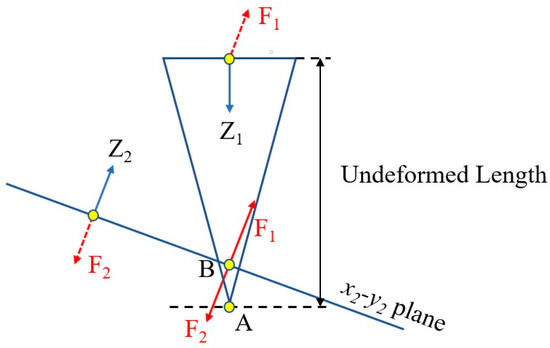
Figure 5.
Schematic diagram of bump stop force.
When the point on the first body becomes embedded in the material of the second part, it indicates that the two objects are in contact, and according to Newton’s third law, equal and opposite forces are generated at the projection of Z1 on the plane (marked B in the figure above). The direction of the force is given by the normal to the plane. The magnitude of the force is given by:
where k is the spring stiffness, defl is the penetration depth, f(defl) is the function of the variable spring stiffness force with the penetration depth, c is the damping constant, d is the penetration velocity, f(d) is the function of the variable spring damping force with the penetration velocity, fa is the constant actuating force, and f(t) is the time-varying actuating force.
2.5. Simulation Settings and Initial Conditions
After the establishment of the NLG model, the aircraft weight is applied in the center of gravity coordinate system of the fuselage, and the aircraft runway is further established. The taxiing process of the aircraft is simulated by the aircraft taxiing speed and initial excitation. When the taxiing speed is stabilized at 50 m/s, an instantaneous exciting force of 5000 N is applied to the center of the left rotating shaft at the moment of 3 s, and the direction is the heading, as presented in Figure 6. The ending time is 6 s, and the maximum solution step is set to 0.01 s. The DYNAMIC analysis type is selected, and the BDF method is used to solve the problem. The main parameters of the NLG are described in Table 3, and the data are provided by the partner company.
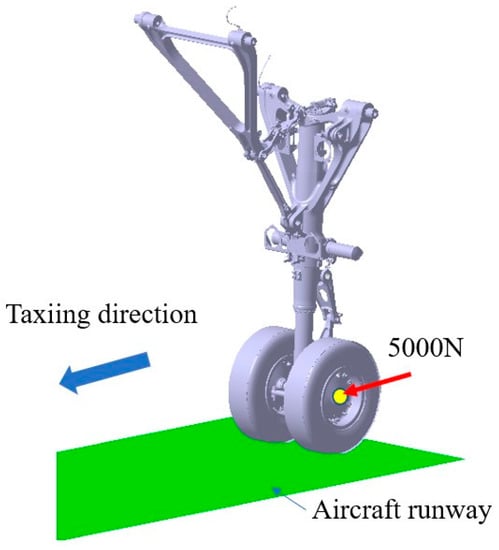
Figure 6.
Instantaneous exciting force position.

Table 3.
Main parameters of the NLG.
3. Evaluation Method
The sensitivity of NLG shimmy stability to joint clearance wear depends on two factors: the position of joint clearance in the NLG (referred to as “position factor”) and the amount of joint wear itself (referred to as “wear factor”). The influence of joint clearance on shimmy will be evaluated from the above two factors.
3.1. Position Factor of NLG Joint
Through the analysis of the joint characteristics of the NLG, it can be seen that the piston and the outer cylinder are cylindrical pairs; the upper resistance rod, the lower resistance rod and the lower locking brace rod form a compound hinge; the upper locking brace rod and the lower locking cylinder are ball pairs; and the others are rotating pairs. The motion mechanism diagram is depicted in Figure 7. The NLG has a total of 12 parts, 14 rotating pairs, 1 ball pair and 1 cylindrical pair, with a total of 16 low pairs. The DoF F of the NLG mechanism is
where n is the number of parts, pl is the number of low pairs, and ph is the number of high pairs.
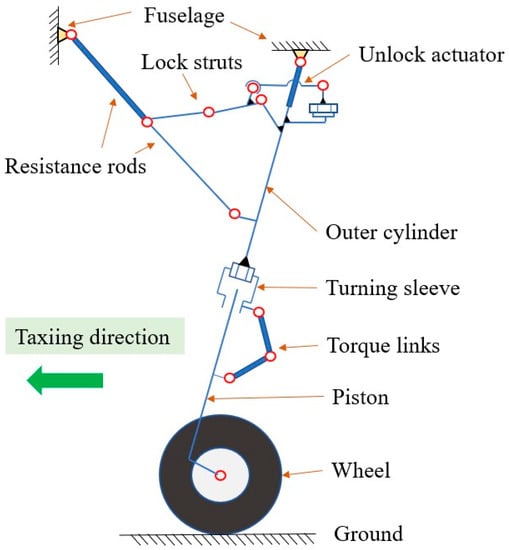
Figure 7.
Schematic diagram of motion mechanism of the NLG.
Based on Equation (24), it is calculated that the simplified NLG model contains the following four DoF: (1) the DoF of the NLG to realize the lower lock control; (2) the relative DoF between the outer cylinder and the turning sleeve around the axis to realize the turning function of the NLG; (3) the DoF of the piston relative to the turning sleeve and the outer cylinder moving along the axis to realize the landing shock absorber function of the NLG; (4) the DoF of wheel rotation around the axis to realize the taxiing function.
After the wheel of the NLG is excited laterally by the ground, the ground excitation is transferred from the wheel to the axle, and then from the lower torque link, the upper torque link, the turning sleeve and the outer sleeve to the fuselage. From the perspective of transmission path, there are mainly six positions that have influence on the shimmy. From top to bottom, they are as follows: (1) the joint clearance between the fuselage and the NLG; (2) the joint clearance between the outer cylinder and the turning sleeve; (3) the joint clearance between the upper torque link and the landing gear rotating sleeve; (4) the joint clearance between the upper torque link and the lower torque link; (5) the joint clearance between the lower torque link and the piston; and (6) the joint clearance between the pulley and the hub. Among them, the joint of the outer cylinder and the turning sleeve is connected by a rack and pinion, and the joint of the axle hub is connected by a pair of tapered roller bearings. In their actual design and use, the assembly clearance and wear clearance are small, which will not be considered in this paper. Therefore, this paper focuses on the influence of position (1), (3), (4) and (5) joint clearance on shimmy.
3.2. Wear Factor of NLG Joint
According to the manufacturing and assembly requirements of the NLG, the assembly dimension chain of each joint is analyzed, Table 4 presents the assembly clearance range of joints at different positions.

Table 4.
Assembly clearance of joints in different positions.
Considering the influence of assembly clearance and wear factors, the radial and axial clearance of 0.1 mm is taken as the reference clearance, and the radial and axial clearance values are increased to 0.2 mm, 0.5 mm and 1.0 mm, respectively. The combination of wear factor studies is depicted in Table 5.

Table 5.
Study combination of wear factors.
4. Result Analysis and Discussion
4.1. Influence of the Joint Clearance between NLG and Fuselage on Shimmy
Figure 8 presents the influence of the joint clearance between NLG and fuselage on shimmy. With the increase in the radial clearance from 0.1 mm to 1 mm, the initial torsion angle increases by 0.03 deg, and the vibration frequency decreases 0.14 Hz, as described in Figure 8a,d. With the axial clearance increases from 0.1 mm to 1 mm, the initial torsion angle will increase 0.03 deg, but it has no effect on the vibration frequency, as shown in Figure 8b. Figure 8c depicts the influence of the coupling of the radial clearance and the axial clearance at the connection between NLG and fuselage on shimmy. In the case of the same excitation, compared with the small clearance combination at the connection between NLG and fuselage, the initial torsion angle of the large clearance combination will increase 0.07 deg, and the vibration frequency will decrease 0.14 Hz. In summary, the clearance between NLG and fuselage has no obvious effect on shimmy within the range of 1 mm clearance, and there is no shimmy phenomenon, which can be ignored.
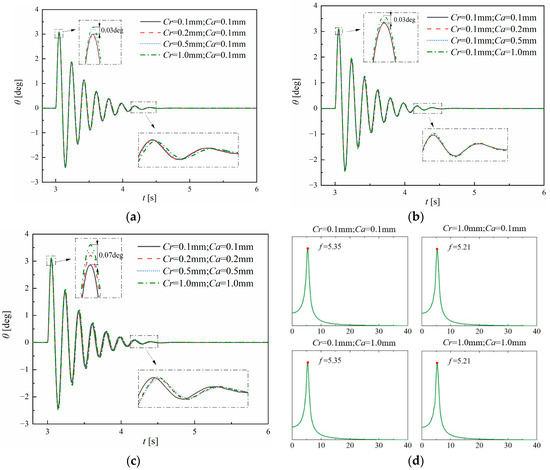
Figure 8.
Influence of joint clearance between NLG and fuselage on shimmy. (a) Radial clearance; (b) axial clearance; (c) radial and axial clearance coupling; (d) shimmy frequency/[Hz].
4.2. Influence of the Joint Clearance between Turning Sleeve and Upper Torque Link on Shimmy
Figure 9 presents the influence of the joint clearance between turning sleeve and upper torque link on shimmy. As the values of radial clearance and axial clearance increase from 0.1 mm to 1 mm, the initial torsion angle and vibration frequency do not change after excitation, as shown in Figure 9a,b; that is, the single radial or axial clearance has no effect on shimmy. Figure 9c depicts the influence of the coupling of radial clearance and axial clearance between turning sleeve and upper torque link on shimmy. Compared with the small clearance combination at the joint of turning sleeve and upper torque link, the initial torsion angle of the large clearance combination will increase by 0.14 deg, and the vibration frequency will increase 0.44 Hz. Shimmy will occur when the clearance value is greater than or equal to 0.2 mm, and the front wheel will have periodic constant amplitude vibration. The larger the clearance, the greater the amplitude, and the amplitude will reach 0.95 deg at the 1 mm clearance value. To sum up, when the radial and axial clearance exists between turning sleeve and upper torque link and the clearance value is greater than 0.2 mm, the front wheel shimmy will occur.
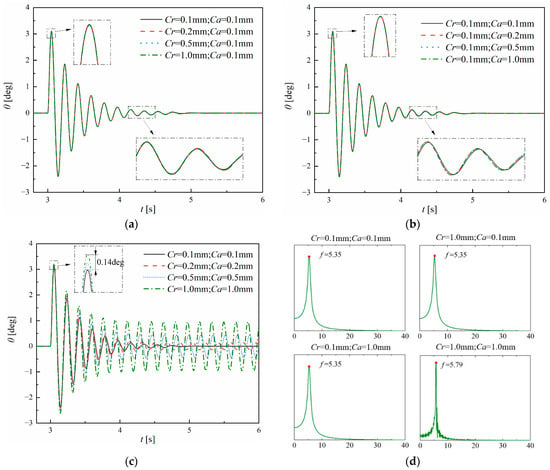
Figure 9.
Influence of joint clearance between turning sleeve and upper torque link on shimmy. (a) Radial clearance; (b) axial clearance; (c) radial and axial clearance coupling; (d) shimmy frequency/[Hz].
4.3. Influence of the Joint Clearance between Upper Torque Link and Lower Torque Link on Shimmy
Figure 10 presents the influence of the clearance between upper torque link and lower torque link on shimmy. As the radial clearance increases from 0.1 mm to 1 mm, the maximum torsion angle and vibration frequency have no effect, as shown in Figure 10a. When the axial clearance increases from 0.1 mm to 1 mm, the initial torsion angle excited increases 0.04 deg, and the vibration frequency increases 0.29 Hz. Shimmy occurs when the axial clearance is greater than or equal to 0.5 mm, and the maximum amplitude is 0.23 deg, as described in Figure 10b. Figure 10c depicts the influence of the coupling of radial clearance and axial clearance on shimmy. Compared with the combination of small clearance at upper and lower torque links, the initial torsion angle of the combination of large clearance will increase by 0.04 deg, and the vibration frequency will increase 0.29 Hz. Shimmy will occur when the clearance is greater than or equal to 0.5 mm, and the maximum amplitude is 0.23 deg, which is consistent with the effect of axial clearance. In summary, the existence of the radial clearance of upper and lower torque link has no effect on shimmy, and it has no coupling effect with the axial clearance, while the effect of the axial clearance is more significant.
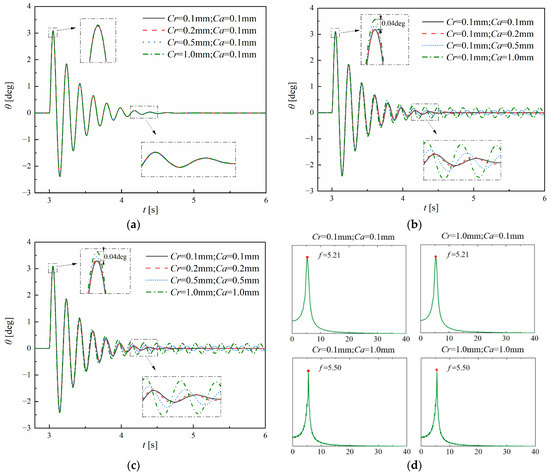
Figure 10.
Influence of joint clearance between upper and lower torque links on shimmy. (a) Radial clearance; (b) axial clearance; (c) radial and axial clearance coupling; (d) shimmy frequency/[Hz].
4.4. Influence of the Joint Clearance between Lower Torque Link and Piston on Shimmy
Figure 11 presents the influence of the clearance between lower torque link and piston on shimmy. With the values of radial clearance and axial clearance increasing from 0.1 mm to 1 mm, the maximum torsion angle and vibration frequency do not change, as shown in Figure 11a,b; that is, the single radial or axial clearance has no effect on shimmy. Figure 11c depicts the influence of the coupling of radial clearance and axial clearance at the upper torque link and piston on shimmy. Compared with the combination of small clearance, the initial torsion angle of large clearance combination will increase 0.11 deg, and vibration frequency will increase 0.44 Hz. Shimmy will occur when the clearance value is greater than or equal to 0.5 mm, and the front wheel will have periodic constant amplitude vibration, the larger the clearance, the greater the amplitude, and the amplitude will reach 0.75 deg at the value of 1 mm clearance. In summary, the upper torque link and piston have an effect on shimmy only when the clearance exists in both radial and axial directions, and the clearance value is greater than 0.5 mm.
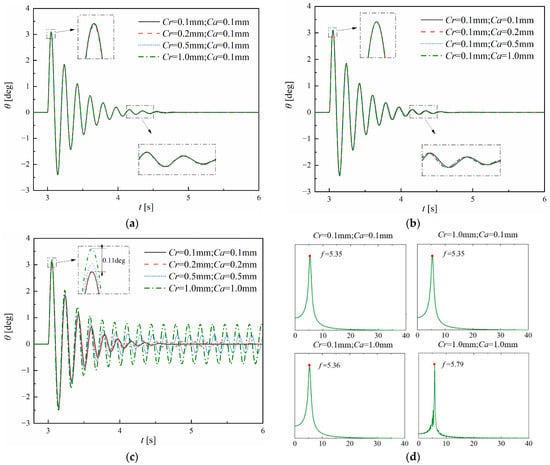
Figure 11.
Influence of joint clearance between torque link and piston on shimmy. (a) Radial clearance; (b) axial clearance; (c) radial and axial clearance coupling; (d) shimmy frequency/[Hz].
4.5. Comparison of the Effects of Joint Clearance at Different Positions
A summary of the results of the study on the effect of joint clearance at different positions on the torsion angle is depicted in Table 6. The results of the comparison table show that within the range of 1 mm clearance, the joint clearance between NLG and fuselage has almost no effect on shimmy, while the other three position clearances have significant influence. The analysis of the NLG structure shows that the relative torsion between NLG and fuselage will not be transferred to the piston but to the NLG rotates as a whole.

Table 6.
Effect of different positions on torsion angle with the increase in joint clearance.
The influence of the clearance between turning sleeve and upper torque link, lower torque link and piston is similar, and only the radial clearance or axial clearance has no impact on the shimmy, while the coupling clearance will make the NLG unstable, and it is easy to produce shimmy. Through the analysis of the structure of the NLG, it is not difficult to see that the connection forms of the above two positions are similar; both are connected by the torque link and the rotating parts, and the joints are all binaural docking structure, as described in Figure 12a. In this case, the axial clearance effect is more obviously constrained by the radial DoF, and it can be affected only in the case of coupling.
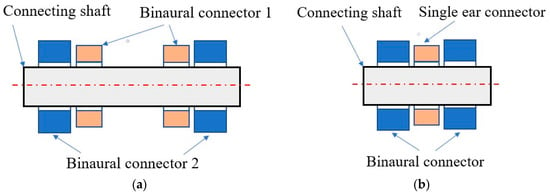
Figure 12.
Joint connection structure. (a) Binaural docking structure; (b) mono-binaural docking structure.
The connection form of upper and lower torque link is mono-binaural docking structure, as shown in Figure 12b, and the radial clearance cannot produce the torsional component, so the radial clearance has no effect on shimmy. The upper and lower torque link is the key component to transfer torque, and its axial clearance is sensitive to shimmy. Shimmy will occur when the clearance value is greater than or equal to 0.5 mm, and the effect of coupling clearance is consistent with that of axial clearance, so there is no coupling effect between the axial clearance and radial clearance.
Consequently, in the design and maintenance of the clearance of NLG, attention should be paid to the excessive axial clearance at the connection of upper and lower torque links, in order to avoid the simultaneous existence of the radial clearance and axial clearance between the turning sleeve and upper torque link, and that between the lower torque link and piston. The above can provide help for pointing out the key position for the design and maintenance of landing gear clearance.
5. Conclusions
In this paper, the shimmy MBD model of NLG with three-dimensional joint clearance is established, and the radial clearance, axial clearance and coupling conditions are analyzed, respectively. Based on this model, a method is proposed to evaluate the influence of joint clearance of NLG on shimmy stability from two aspects of position factor and wear factor. It is found that the joint clearance between the NLG and fuselage has almost no effect on shimmy, while the clearance between the turning sleeve and upper torque link and that between the lower torque link and the piston, upper and lower torque link will reduce the stability of NLG and is prone to shimmy. The axial clearance plays a greater role than the radial clearance in the process of causing the shimmy of the NLG.
The upper and lower torque link is the key component of the NLG to transfer torque, and only the joint axial clearance will make the front wheel shimmy; the radial clearance between turning sleeve and upper torque link, lower torque link and piston suppresses the axial clearance in space, and the coexistence effect is significant, in which case shimmy instability is prone to occur. To sum up, in the maintenance of the clearance of NLG, attention should be paid to the excessive axial clearance at the connection of upper and lower torque links, and to avoid the simultaneous existence of the radial clearance and axial clearance between the turning sleeve and upper torque link, and between lower torque link and piston. The influence characteristics of joint clearance at different positions on shimmy obtained in this paper are helpful for us to understand the influence mechanism of clearance on shimmy, and it can be applied to the design and maintenance of landing gear joints. The next research work can focus on the load transfer and the influence on shimmy of the NLG with multiple joints with clearance at the same time.
Author Contributions
Conceptualization: Y.J. and G.F.; Investigation: P.L., L.Y. and J.D.; Methodology: Y.J. and B.J.; Software: Y.J. and J.D.; Writing—original draft: Y.J. and G.F.; Writing—review and editing, B.J., P.L., L.Y. and J.D.; Project administration: B.J.; Supervision: G.F. and B.J. All authors have read and agreed to the published version of the manuscript.
Funding
This work was funded by the Civil Aircraft Special Project of the MIIT, grant number JZ025-XY-003.
Data Availability Statement
Not applicable.
Acknowledgments
The authors gratefully acknowledge the research grant provided by the Civil Aircraft Special Project of the MIIT (Grant No. JZ025-XY-003) in support of this work.
Conflicts of Interest
The authors declare no conflict of interest.
References
- Grossman, D.T. F-15 Nose Landing Gear Shimmy, Taxi Test and Correlative Analyses. SAE Tech. Pap. 1980, 89, 3781–3791. [Google Scholar] [CrossRef]
- Howcroft, C.; Lowenberg, M.; Neild, S.; Krauskopf, B.; Coetzee, E. Shimmy of an Aircraft Main Landing Gear with Geometric Coupling and Mechanical Freeplay. J. Comput. Nonlinear Dyn. 2015, 10, 1–24. [Google Scholar] [CrossRef]
- Howcroft, C.; Lowenberg, M.; Neild, S.; Krauskopf, B. Effects of Freeplay on Dynamic Stability of an Aircraft Main Landing Gear. J. Aircr. 2013, 50, 1908–1922. [Google Scholar] [CrossRef]
- Atabay, E.; Ozkol, I. Application of a Magnetorheological Damper Modeled Using the Current-Dependent Bouc-Wen Model for Shimmy Suppression in a Torsional Nose Landing Gear with and without Freeplay. J. Vib. Control 2014, 20, 1622–1644. [Google Scholar] [CrossRef]
- William, J. Moreland The Story of Shimy. J. Aeronaut. Sci. 1954, 21, 793–808. [Google Scholar]
- Rahmani, M.; Behdinan, K. On the Effectiveness of Shimmy Dampers in Stabilizing Nose Landing Gears. Aerosp. Sci. Technol. 2019, 91, 272–286. [Google Scholar] [CrossRef]
- Feng, F.; Nie, H.; Zhang, M.; Peng, Y. Effect of Torsional Damping on Aircraft Nose Landing-Gear Shimmy. J. Aircr. 2015, 52, 561–568. [Google Scholar] [CrossRef]
- Rahmani, M.; Behdinan, K. Structural Design and Optimization of a Novel Shimmy Damper for Nose Landing Gears. Struct. Multidiscip. Optim. 2020, 62, 2783–2803. [Google Scholar] [CrossRef]
- Rahmani, M.; Behdinan, K. Parametric Study of a Novel Nose Landing Gear Shimmy Damper Concept. J. Sound Vib. 2019, 457, 299–313. [Google Scholar] [CrossRef]
- Rahmani, M.; Behdinan, K. Investigation on the Effect of Coulomb Friction on Nose Landing Gear Shimmy. J. Vib. Control 2019, 25, 255–272. [Google Scholar] [CrossRef]
- Thota, P.; Krauskopf, B.; Lowenberg, M. Nonlinear Analysis of the Influence of Tyre Inflation Pressure on Nose Landing Gear Shimmy. In Proceedings of the AIAA Modeling and Simulation Technologies Conference, Chicago, IL, USA, 10–13 August 2009. [Google Scholar] [CrossRef]
- Thota, P.; Krauskopf, B.; Lowenberg, M. Multi-Parameter Bifurcation Study of Shimmy Oscillations in a Dual-Wheel Aircraft Nose Landing Gear. Nonlinear Dyn. 2012, 70, 1675–1688. [Google Scholar] [CrossRef]
- Ran, S.; Besselink, I.J.M.; Nijmeijer, H. Application of Nonlinear Tyre Models to Analyse Shimmy. Veh. Syst. Dyn. 2014, 52, 387–404. [Google Scholar] [CrossRef]
- Terkovics, N.; Neild, S.; Lowenberg, M.; Krauskopf, B. Bifurcation Analysis of a Coupled Nose-Landing-Gear-Fuselage System. J. Aircr. 2014, 51, 259–272. [Google Scholar] [CrossRef]
- Kewley, S.; Lowenberg, M.; Neild, S.; Krauskopf, B. Investigation into the Interaction of Nose Landing Gear and Fuselage Dynamics. J. Aircr. 2016, 53, 881–891. [Google Scholar] [CrossRef]
- Jiang, Y.; Feng, G.; Liu, P.; Yuan, L.; Ding, J.; Jiang, B. Influence of Nose Landing Gear Torsional Damping on the Stability of Aircraft Taxiing Direction. Aerospace 2022, 9, 729. [Google Scholar] [CrossRef]
- Cheng, L.; Cao, H.; Zhang, L. Two-Parameter Bifurcation Analysis of an Aircraft Nose Landing Gear Model. Nonlinear Dyn. 2021, 103, 367–381. [Google Scholar] [CrossRef]
- Thota, P.; Krauskopf, B.; Lowenberg, M. Bifurcation Analysis of Nose-Landing-Gear Shimmy with Lateral and Longitudinal Bending. J. Aircr. 2010, 47, 87–95. [Google Scholar] [CrossRef]
- Thota, P.; Krauskopf, B.; Lowenberg, M. Interaction of Torsion and Lateral Bending in Aircraft Nose Landing Gear Shimmy. Nonlinear Dyn. 2009, 57, 455–467. [Google Scholar] [CrossRef]
- Sura, N.K.; Suryanarayan, S. Lateral Response of Nonlinear Nose-Wheel Landing Gear Models with Torsional Free Play. J. Aircr. 2007, 44, 1991–1997. [Google Scholar] [CrossRef]
- Sateesh, B.; Maiti, D.K. Non-Linear Analysis of a Typical Nose Landing Gear Model with Torsional Free Play. Proc. Inst. Mech. Eng. Part G J. Aerosp. Eng. 2009, 223, 627–641. [Google Scholar] [CrossRef]
- Rahmani, M.; Behdinan, K. Interaction of Torque Link Freeplay and Coulomb Friction Nonlinearities in Nose Landing Gear Shimmy Scenarios. Int. J. Non. Linear. Mech. 2020, 119, 103338. [Google Scholar] [CrossRef]
- Marques, F.; Isaac, F.; Dourado, N.; Flores, P. An Enhanced Formulation to Model Spatial Revolute Joints with Radial and Axial Clearances. Mech. Mach. Theory 2017, 116, 123–144. [Google Scholar] [CrossRef]
- Yan, S.; Xiang, W.; Zhang, L. A Comprehensive Model for 3D Revolute Joints with Clearances in Mechanical Systems. Nonlinear Dyn. 2015, 80, 309–328. [Google Scholar] [CrossRef]
- Yin, Y.; Xu, K.; Nie, H.; Wei, X.; Wang, H. Dynamics Analysis of Spatial Landing-Gear Mechanism with Hinge Clearance and Axis Deviation. J. Aircr. 2021, 58, 30–42. [Google Scholar] [CrossRef]
- Zheng, E.; Zhu, R.; Zhu, S.; Lu, X. A Study on Dynamics of Flexible Multi-Link Mechanism Including Joints with Clearance and Lubrication for Ultra-Precision Presses. Nonlinear Dyn. 2016, 83, 137–159. [Google Scholar] [CrossRef]
- Lai, X.; Lai, Q.; Huang, H.; Wang, C.; Yang, J.; Zhang, Y. New Approach to Assess and Rank the Impact of Revolute Joint Wear on the Kinematic Accuracy in the Low-Velocity Planar Mechanism. Adv. Eng. Softw. 2016, 102, 71–82. [Google Scholar] [CrossRef]
- Chen, Y.; Liu, K.; Qiu, R.; Yu, C.; Xia, X.; Sun, Y. Dynamic Analysis of Planar Multibody Systems Considering Contact Characteristics of Ball Bearing Joint. Int. J. Struct. Stab. Dyn. 2021, 21, 1–27. [Google Scholar] [CrossRef]
- Rahmani, M.; Behdinan, K. Studying the Effect of Freeplay on Nose Landing Gear Shimmy Using a Fully Nonlinear Model. Proc. ASME Des. Eng. Tech. Conf. 2018, 6, 1–11. [Google Scholar] [CrossRef]
- XU, K.; YIN, Y.; YANG, Y.; NIE, H.; WEI, X. Bifurcation Analysis of Dual-Sidestay Landing Gear Locking Performance Considering Joint Clearance. Chin. J. Aeronaut. 2022, 35, 209–226. [Google Scholar] [CrossRef]
- Tourajizadeh, H.; Zare, S. Robust and Optimal Control of Shimmy Vibration in Aircraft Nose Landing Gear. Aerosp. Sci. Technol. 2016, 50, 1–14. [Google Scholar] [CrossRef]
- Sanches, L.; Guimarães, T.A.M.; Marques, F.D. Nonlinear Energy Sink to Enhance the Landing Gear Shimmy Performance. Acta Mech. 2021, 232, 2605–2622. [Google Scholar] [CrossRef]
- Laporte, D.J.; Lopes, V.; Bueno, D.D. An Approach to Reduce Vibration and Avoid Shimmy on Landing Gears Based on an Adapted Eigenstructure Assignment Theory. Meccanica 2020, 55, 7–17. [Google Scholar] [CrossRef]
- Orlando, C. Nose Landing Gear Simple Adaptive Shimmy Suppression System. J. Guid. Control. Dyn. 2020, 43, 1298–1312. [Google Scholar] [CrossRef]
- Li, Y.; Howcroft, C.; Neild, S.A.; Jiang, J.Z. Using Continuation Analysis to Identify Shimmy-Suppression Devices for an Aircraft Main Landing Gear. J. Sound Vib. 2017, 408, 234–251. [Google Scholar] [CrossRef]
- Liu, H.; Gu, H.; Chen, D. Application of High-Speed Solenoid Valve to the Semi-Active Control of Landing Gear. Chin. J. Aeronaut. 2008, 21, 232–240. [Google Scholar] [CrossRef]
- Orlando, C.; Alaimo, A. A Robust Active Control System for Shimmy Damping in the Presence of Free Play and Uncertainties. Mech. Syst. Signal Process. 2017, 84, 551–569. [Google Scholar] [CrossRef]
- Smiley, R.F. Correlation, Evaluation, and Extention of Linearized Theories for Tire Motion and Wheel Shimmy. NACA TN-3632, 1 June 1956. [Google Scholar]
- Young, W.C.; Budynas, R.; Sadegh, A. Roark’s Formulas for Stress and Strain, 9th ed.; McGraw-Hill: New York, NY, USA, 2011; ISBN 9781260453768. [Google Scholar]
Disclaimer/Publisher’s Note: The statements, opinions and data contained in all publications are solely those of the individual author(s) and contributor(s) and not of MDPI and/or the editor(s). MDPI and/or the editor(s) disclaim responsibility for any injury to people or property resulting from any ideas, methods, instructions or products referred to in the content. |
© 2023 by the authors. Licensee MDPI, Basel, Switzerland. This article is an open access article distributed under the terms and conditions of the Creative Commons Attribution (CC BY) license (https://creativecommons.org/licenses/by/4.0/).